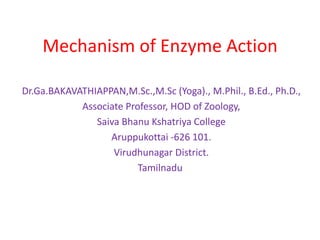
Enzyme mechanism
- 1. Mechanism of Enzyme Action Dr.Ga.BAKAVATHIAPPAN,M.Sc.,M.Sc (Yoga)., M.Phil., B.Ed., Ph.D., Associate Professor, HOD of Zoology, Saiva Bhanu Kshatriya College Aruppukottai -626 101. Virudhunagar District. Tamilnadu
- 2. Enzymes are proteins that act as biological catalysts (biocatalysts). Catalysts accelerate chemical reactions. The study of enzymes is called Enzymology. • Enzymes are complex macromolecules with high molecular weight. • They catalyse biochemical reactions in a cell. They help in the breakdown of large molecules into smaller molecules or bring together two smaller molecules to form a larger molecule. • Enzymes are specific in action. • The molecules upon which enzymes may act are called substrates, and the enzyme converts the substrates into different molecules known as products.
- 3. Active site All enzymes molecules contain a special cleft or pocket in its structure which is actively involved in catalysis. This cleft or pocket is known as active site of enzyme. Active site binds with substrate and the functional group present in active site modify the substrate during catalysis.
- 7. • Enzymes are highly specific. • They must bind to a specific substrate before they can catalyze a chemical reaction. • At present, there are two models, which attempt to explain enzyme specificity: • (1) lock-and-key model and • (2) induced fit model. • Like a key into a lock, only the correct size and shape of the substrate (the key) would fit into the active site (the key hole) of the enzyme (the lock).
- 8. Mechanism of Enzyme Action 1. Lock and Key model • The lock and key model theory first postulated by Emil Fischer in 1894 shows the high specificity of enzymes. According to this model, shape of active site of enzyme is complementary to the shape of substrate molecules. i.e. the substrate is like a key whose shape is complementary to the enzyme which is supposed to be lock and they fit perfectly. • Enzymes catalyze only those substrates which fit perfectly on the active site of that enzyme. – Once the product is formed, they no longer fit into the active site and escape into surrounding medium. •
- 9. • According to lock and key model, enzymes behave as rigid molecules. However, most enzymes are globular and are flexible with varying shape. • Most enzymes are far larger than the substrates molecules that act on and the active site is usually a very small portion of the enzyme, between 3 and 12 amino acids. The remaining amino acids which make the bulk of the enzyme, function to maintain the correct globular shape of the enzyme.
- 10. In 1959, Koshland suggested a modification to the ‘Lock and Key’ hypothesis which is known as ‘Induced fit’ hypothesis. • Working from evidence that suggested that some enzymes and their active site are more flexible. To this, he proposed that the active site can modify its shape as the substrate interact with the enzyme. • The amino acids which make up the active site are moulded into precise shape which enable the enzyme to perform its catalytic function most efficiently. • For instance, a suitable analogy to describe Induced fit model would be that of a hand changing the shape of the glove as the individual put on the glove. Therefore in this case, glove is the active site of enzyme and the hand is substrate. • However, in some cases, the substrate molecules changes slightly as it enters the active site before binding. 2. Induced fit model.
- 12. • Part of an enzyme where substrate molecules get attached is known as an active site. On attachment to the active site, the substrate is changed into the product. • Bonds like hydrogen bonds, hydrophobic interactions, or temporary non-covalent interactions are formed which leads to the formation of an enzyme-substrate complex. • The induced-fit model is generally considered the more correct version. This theory maintains that the active site and the substrate are, initially, not perfect matches for each other. • Rather, the substrate induces a change of shape in the enzyme. This is similar to placing your hand in a glove. Getting the first finger in may be difficult, but, once you complete this initial step, the glove slides on easily (read, 'with much less energy') because it is now properly aligned for your hand. • Induced-fit model stated that when the substrate comes in contact with the active site, the active site modulates according to the shape of the substrate to form an enzyme- substrate complex.